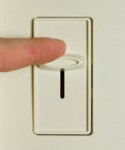
Beauty may be only skin deep, but the seemingly superficial matter of home decor, from carpet to ceiling fans, can dramatically shape your well-being on a number of fronts. Accordingly, we should view our living spaces holistically, not just as so much wood and metal but as a multi-dimensional network of interrelated factors. Here’s a basic bottom-to-top blueprint of how your home decor can affect your health:
Screening #1: Physical Toxins
While it’s only one part of a larger story, our pragmatic, bottom-line society often equates health with the absence of any bodily disease, and indeed there are a number of routine checks you can perform to rid your house of noxious agents. Unfortunately, because most of the usual suspects in the daily attack on our system are not readily visible: either they stem from a buildup of tiny or even invisible particles (bacteria, mildew) or they lurk unseen in the innards of the house’s structure. In particular, check out the following elements of decor that can affect your health:
- Kitchens: We’d like to think them as the most immaculate areas of the house, but kitchens are a hotbed for the spread of illness because of the high traffic of volatile, potentially contaminated foodstuffs. The kitchen sink, for example, is likely to contain as many as 1000 times more bacteria as its bathroom counterpart. Other unexpected germ dens are coffee machine filters and control knobs on stoves.
- Plumbing Fixtures: The areas around water taps and pipes are ideal breeding ground for mold and mildew, which can trigger allergies, asthma, and other respiratory maladies.
- Ventilation/Air Conditioning: A buildup of dust and debris in heating shafts and especially dirty AC filters can trigger the chronic respiratory diseases just noted, and may also cause headaches, nausea, dry eyes, and low energy.
- Fireplace Toxins: If you still have a wood burning fireplace in your house, you could be in danger of releasing dangerous toxins in the air each time you light a fire. Instead, try a bio-ethanol fireplace which won’t emit any dangerous fumes into the air you and your family breathe. This will emit virtually no CO2 and the little that is emitted doesn’t threaten human health and will ensure better air quality in your home.
Screening #2: External Interface
A household is not just a self-contained unit, but a dynamic organism that has a two-way relationship with the world outside. On several planes, consider whether that relationship is a balanced one. Closing out too much of the world can tax us thoroughly: a lack of fresh air ventilation may exacerbate the respiratory problems mentioned above, while a deficiency of sunlight can lead to mental afflictions such as insomnia, seasonal affective disorder, and depression.
Conversely, we should be conscious of the impact of decor affecting the health of the world beyond our front door. In other words, we should be as aware as possible of where the materials of our home come from, and where they go when discarded. Using recycled furniture, finding second lives for unwanted items, and buying sustainable natural materials such as bamboo flooring may not immediately impact your own health, but these green choices promote the general well-being of everyone.
Screening #3: Invisible Forces
Bacteria and buying green may already have been unobserved variables, but in particular this means even more subtle calibrations of harmony between things. One could summarize this principle as Feng Shui, or the Chinese system of cultivating harmonized living spaces by arranging internal elements in a precise way in relation to each other and the world around.
On the one hand, while formal Feng Shui claims to be a manifestation of abstract cosmic forces, its objective claims are in fact controversial. For example, there is little hard evidence to show that placing certain objects in a corner of a room bring prosperity, a typical piece of advice in the Feng Shui system. On the other hand, the careful attention to spatial psychology at work in Feng Shui is more immediate. Freeing corners of clutter and orchestrating a total color scheme based on place and function, as examples, do in fact have bearing on relieving anxiety, staving off depression, and other psychological outcomes.
While we can break down these considerations into tiers, the point of a holistic approach is to see physical and mental phenomena operating together: think of any action as a string tugging at a web. For example, while taking steps to make our home greener may have immediate physical events, we also find emotional well-being in knowing we’re taking action in a positive direction.
AUTHOR: Naomi Shaw is a freelance writer from Southern California. She loves writing about home decor and home design. She’s currently re-doing her home and is using some of the tips listed above to keep herself and her family healthy.
 8 Popular Energy Efficiency Upgrades that DON’T Save Energy or Cash
8 Popular Energy Efficiency Upgrades that DON’T Save Energy or Cash 3 Green Lighting Tips Beyond the Obvious
3 Green Lighting Tips Beyond the Obvious Conquering Fear by Embracing Something Larger Than Yourself
Conquering Fear by Embracing Something Larger Than Yourself